Ten Pound Island Light

The Ten Pound Island Light is a historic lighthouse in Gloucester Harbor in Gloucester, Massachusetts. It is located on Ten Pound Island, near the eastern end of the harbor. The tower, built in 1881, is a conical cast iron structure 30 feet (9.1 m) tall, replacing a stone tower first built on the site in 1821. The main body is painted white, and the top is painted black. The tower is the only surviving part of a more extensive light station, which included a keeper's house and an oil house. The island additionally hosted a federal fish hatchery and a Coast Guard air (seaplane) station; only ruins survive.The lighthouse was listed on the National Register of Historic Places in 1988. Both Winslow Homer and Fitz Henry Lane painted the first tower.
Excerpt from the Wikipedia article Ten Pound Island Light (License: CC BY-SA 3.0, Authors, Images).Ten Pound Island Light
Fremont Street, Gloucester
Geographical coordinates (GPS) Address Website Nearby Places Show on map
Geographical coordinates (GPS)
| Latitude | Longitude |
|---|---|
| N 42.601861111111 ° | E -70.665555555556 ° |
Address
Tenpound Island
Fremont Street
01930 Gloucester
Massachusetts, United States
Open on Google Maps










